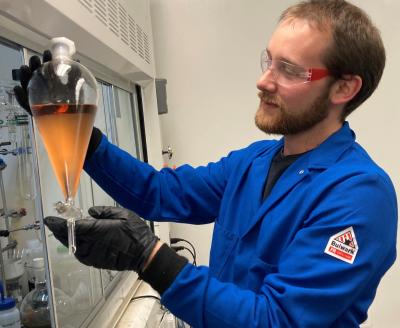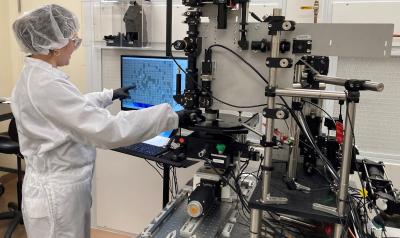US-based Terecircuits develops technologies and manufacturing processes for microassembly based on a new class of photo-chemical polymers. The company focuses on the development of a microLED photo-chemical mass transfer process. The company's CEO, Wayne Rickard, will give a talk at the upcoming MicroLED-Connect startup showcase event later this week, and he was kind enough to send us a short update on the company's technology and status, and his views on the microLED industry and market.
Hello Wayne, thank you for your time. Can you tell us a bit about Terecircuits, your technology and current status?
Terecircuits is a Materials Company with leading-edge know-how in synthesis, characterization, and delivery of proprietary encapsulants, polymers, and thin film coatings for the semiconductor and display industries.
In general, our materials address the unique advanced packaging challenges of precision assembly: die-on-die, heterogeneous integration, 3D stacking, chiplets, SiC die attach, and – as it relates to displays - MicroLED mass transfer.
Our flagship product is Terefilm, a photochemistry-based transfer material specifically designed to meet the requirements of Laser Induced Forward Transfer (LIFT). Terefilm excels at managing extremely small, thin, or fragile components that traditional tools struggle with. It outperforms other materials in cleanliness, transfer accuracy, and requires less activation energy. We can also demonstrate selective release by using a mask to target individual components.
Terefilm is shipping today at pilot-line volumes and we are adding new evaluations regularly.
What are the next steps for Terecircuits? What is your go-to-market strategy in the microLED industry?
We leverage our process and materials across several verticals by partnering with Capital Equipment manufacturers to improve the Cost of Ownership (COO) of their tools. In the MicroLED industry, that means partnering with OEMs to understand their requirements and then working with their preferred LIFT tool partner to dial in the process parameters needed to successfully transition from lab to fab.
To demonstrate how we achieve industry-leading placement accuracy and cleanliness, we built a lab-scale tool capable of transferring customer-supplied MicroLEDs from a Terefilm coated donor plate.
We haven't invested heavily in marketing because, over time, those developing laser-based transfer tools recognize the critical role of the transfer material for precision, consistency, and a repeatable process. Terefilm is to LIFT tools as photoresist is to lithography; the tool and material work together.
What do you feel are the main challenges for the microLED industry and market today?
MicroLEDs have a lot of compelling advantages over OLED in terms of brightness, color gamut, and viewing angle, but with ongoing improvements in OLED technology, many of those advantages are diminishing. Eric Virey at Yole has pointed out, correctly I believe, that MicroLEDs will need to get cost-competitive with OLED in the future or face being relegated to niche applications. That means reducing the cost of components.
At the size of MicroLEDs in today’s televisions (34 x 58μm) the yielded cost of components is too expensive for commercial viability – over $7,000 for a 4K TV. So while you may not need a smaller MicroLED to make a beautiful display, you do need a smaller MicroLED to get the cost down by increasing the yield from the epiwafer fabrication process.
That leads to the next problem, which is that a commercially viable range of 2-8μm is too small to be handled by conventional placement tools, and even most of the contenders for mass transfer. At 2-8μm, MicroLEDs are smaller than a red blood cell, and millions of them need to be transferred and placed on substrates with < 1 micron of placement accuracy. This second challenge is our focus at Terecircuits.
What are your thoughts regarding the microLED market at this stage? How close are we to commercialized microLED displays?
We work with a lot of the key industry players, and I have reason to be optimistic. MicroLEDs are still an emerging technology, but like so many other innovations that depend on ecosystem-wide advances, the timing of commercialization has a high level of systemic uncertainty. There are still problems to solve, but none of them are insurmountable. Those of us who are close to the problems are not slowing down, in fact the rate of progress seems to be increasing. My best guess is that it will take more than 5 years but less than a decade to turn the corner. At that point we will see applications emerge that completely upend the user experience, in ways we cannot imagine today.
Many say MicroLED will disrupt the display value chain because it is not just an evolution of existing display technology. How do you see the changes and how will that impact Terecircuits 's position in the industry?
MicroLED displays are the only manufactured product I can think of where there is a structured assembly of millions of components, each smaller than a grain of pollen. Then each component acts individually but also in unison to achieve a brilliant display. The analogies in nature are processes like protein synthesis, DNA replication and photosynthesis, which when you think about it, are all chemically driven processes.
At Terecircuits we are literally replacing mechanical processes like pick & place and stamping with a photochemically driven process for assembly. Mimicking what works in nature has never been a bad idea, and we see applications for our technology in other areas besides MicroLED. It may just happen that the triple-challenge of moving millions of vanishingly small objects with micron-scale accuracy just showed up first in displays. Disruption bodes well for Terecircuits.
Thank you Wayne, looking forward to hearing your lecture later this week!


